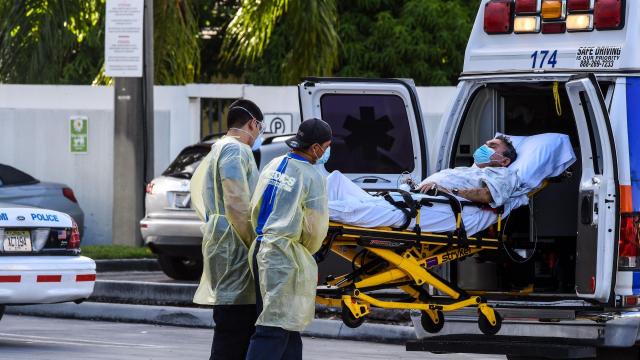As of Wednesday afternoon, according to at least one tracker, more than 100,000 Americans are hospitalised with covid-19. The “milestone” is yet another sign that the country is again being battered by the pandemic, despite the availability of several effective vaccines. Data continues to indicate that most of those hospitalised are likely to be unvaccinated.
The grim update comes courtesy of media outlet BNO News, via their tracker developed with Newsnodes, based on data collected from the federal government and states.
Almost a fifth of all current hospitalisations (around 17,000) are in Florida. Texas is second on the list with around 13,000 hospitalised residents, followed by California with almost 9,000. As of yesterday, more than a quarter of those hospitalised were in intensive care and many are dying. The average daily death toll has once again reached over 1,000, mirroring the peak seen last summer.
In the past few months, many countries have faced resurgent and deadly waves of the pandemic, aided by the arrival of the much more transmissible Delta variant. Even highly vaccinated countries like the UK and Israel have recently experienced or are currently experiencing surges of new cases. But in the UK at least, deaths and hospitalizations still remained relatively low during their latest peak. Not so in the U.S., largely in part due to a vaccine rollout that started off fast but has struggled as of late. Currently, about 52% of all Americans are fully vaccinated, compared to 63% of the UK.
The evidence is pretty strong now that the vaccines have lost some of their potency in preventing any infection from covid-19 compared to when they first arrived. Some of this loss probably reflects the modest but real waning over time of antibody-provided immunity to the initial invasion of the coronavirus, but Delta itself may be better at breaking through the frontlines of our immune system than earlier strains. It’s less certain whether the vaccines are substantially worse at preventing symptoms from Delta, though, and nearly all the data indicate that they are still highly effective at preventing severe illness and death.
A study from the New York State Department of Health published last week, based on surveillance data of New York City residents, found that the age-adjusted vaccine effectiveness (of all three currently authorised or approved vaccines) against any infection dropped from 91.7% to 79.8% between early May to late July, right as Delta was becoming dominant in the area.
During that same time, though, effectiveness against hospitalisation stayed high at over 90%. In a new study of Los Angeles residents published yesterday, only about 3% of those hospitalised between May to July were fully vaccinated, meaning that unvaccinated people were around 29 times more likely to be hospitalised. Other research has suggested that vaccines have prevented more than 100,000 deaths and counting in the U.S.
It may be tempting to write off the unvaccinated and hospitalised as deserving and lonely victims of their own hubris. But in the worst-hit areas, these cases are once again overtaxing hospitals and intensive care units, while the sheer amount of community spread means that even fully vaccinated people aren’t as safe from severe illness and death as they could be. Younger children, while at far lower risk of serious harm than adults, are still unable to get vaccinated, and hospitalisations are increasing for them as well. Every death, whether among the vaccinated or not, also leaves behind tragedy for their loved ones.
As before, this latest wave of the pandemic will eventually reach its peak and there is reason for optimism moving forward. States and businesses are increasingly issuing vaccine mandates, buoyed by the recent full approval of the Pfizer/BioNTech vaccine by the U.S. Food and Drug Administration. And vaccine authorization for younger children may arrive before the end of the year.
If these measures do substantially improve the vaccination rate, perhaps combined with the uptake of boosters, the U.S. may be able to forestall another large wave of death and serious illness come fall and winter. But that possibility no longer looks as secure as it might have just a few months ago.
